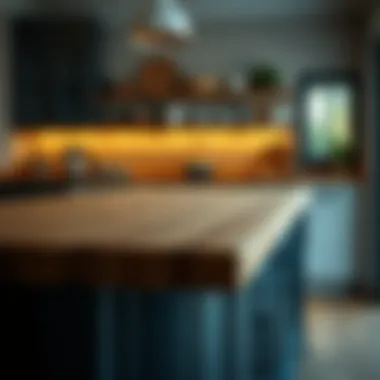The Diverse Benefits of Butcher Block Countertops


Intro
Butcher block countertops have long stood the test of time, capturing the hearts of homeowners, designers, and DIY aficionados alike. Their ability to combine rustic charm with modern functionality makes them a salient choice for many kitchen settings. This material not only enriches the aesthetics of any cooking space but also serves practical needs, such as durability and ease of maintenance. In this piece, we aim to explore the key attributes and advantages of butcher block countertops, providing a detailed understanding of how they fit into current design trends and the materials used.
Homeowners and designers alike are increasingly faced with the challenge of blending style with functionality. The decision to choose butcher block can be informed by various factors such as its sustainability, timeless appeal, and adaptability. Whether creating a homey cooking environment or a contemporary culinary haven, butcher block countertops extend a versatile solution to elevate your kitchen.
Design Trends
Butcher block countertops are not just a functional choice; they embody trends that cater to both contemporary tastes and nostalgic sensibilities.
Contemporary Styles
In modern kitchens, butcher block signifies clean lines and minimalistic designs. Think about pairing it with stainless steel appliances or sleek cabinetry where the warm textures of the wood act as a counterbalance to cooler materials. Many designers favor lighter woods like maple for a fresh appearance. The combination of butcher block with modern features like recessed lighting and open shelving creates an inviting atmosphere without compromising a sense of spaciousness.
Here are some ways contemporary designers are integrating butcher block:
- Color Contrast: Mix darker countertops with lighter wood blocks.
- Multiple Textures: Combine butcher block with surfaces like quartz or granite for diversity.
- Functional Features: Adding built-in spice racks or cutting boards directly in the countertop shows trends leaning towards smart design.
Vintage Inspirations
On the flip side, the retro aesthetic is making a comeback, driving many homeowners to incorporate vintage-inspired butcher block countertops. Imagine kitchens adorned with reclaimed wood, exuding a history that newer materials simply can’t replicate. Vintage butcher block slices may be treated to reveal rich, worn grains, showcasing craftsmanship from a bygone era.
For instance, many kitchens now emphasize:
- Farmhouse Looks: White shiplap walls and distressed wooden islands can absorb the timeless quality of butcher blocks.
- Eclectic Styles: Grounded in vintage, pairup butcher block with mismatched cabinets from flea markets, bringing a sense of whimsy and personality to the kitchen.
- Nostalgic Fixtures: Using retro appliances alongside butcher block can create a cohesive scheme that reminisces simpler times.
"In a world of ever-evolving trends, butcher block countertops remain a steadfast choice, marrying the old with the new, and proving to be as adaptable as they are timeless."
Foreword to Butcher Block Countertops
When it comes to choosing a kitchen countertop, the options can be overwhelming. However, butcher block countertops stand out as a versatile and aesthetically pleasing choice. Known for their natural beauty and warmth, these surfaces are not just about looks. They serve practical purposes that can benefit any kitchen environment. The appeal of butcher block transcends mere fashion; it incorporates functionality, ease of maintenance, and ecological considerations.
Butcher block countertops are constructed from straight cuts of wood glued together in various configurations, making them durable and adaptable for diverse kitchen styles. Whether you’re preparing a family feast or simply enjoying your morning coffee, these surfaces can elevate your kitchen experience. They bring in a touch of nature that is not easily replicated by synthetic materials, thus inviting a cozy vibe that resonates throughout the home.
In this discussion, we will dig into two key aspects: the definition of butcher block and its historical context. Understanding what butcher block is, along with its rich history, provides valuable background information that underscores its relevance in contemporary design. This exploration is essential for homeowners looking to invest in quality, for designers striving to fuse practicality with art, and for anyone who appreciates craftsmanship.
"Butcher block countertops embody the harmony between tradition and modernity, transforming kitchens into spaces of warmth and function."
Defining Butcher Block
Butcher block essentially refers to a work surface made primarily from wood, typically hardwoods such as maple, oak, or walnut. Each board is laid out in a sequence, bonded using adhesives to create a sturdy surface capable of handling the rigors of food preparation. Unlike other materials, butcher block has a tactile quality that breathes life into kitchen spaces. It's an ideal balance of utility and artistry, harmonizing well with a variety of interior design themes.
Moreover, butcher block often features a unique grain pattern that can vary from piece to piece. This variability results in a one-of-a-kind kitchen surface that can’t be replicated by synthetic options. Homeowners and chefs alike appreciate its forgiving nature; knife markings and scratches add character over time, further enhancing its allure.
The simple act of chopping veggies on a butcher block, for instance, can create a sense of authenticity in one’s cooking process. This alludes to its historical roots—originally utilized in butcher shops, they were specially designed to withstand the demands of butchering meats, thus the name.
Historical Context
To truly appreciate butcher block countertops, it’s essential to delve into their history. The origins of butcher block can be traced back to the early 19th century. Initially, they played a vital role in butcher shops, providing an essential surface for cutting meats. Craftsmen took great pride in these counters, often customizing them to suit their specific needs, underscoring the melding of artistry and functionality from the get-go.
As kitchens evolved from utilitarian spaces into areas for social interaction and creativity, the transition of butcher blocks into home kitchens began. This shift represented a changing perception of kitchen spaces—from purely functional to a more inviting and aesthetic role. Homeowners started viewing butcher blocks not just as work surfaces but as central pieces that tied together the kitchen’s overall style.
The renewed interest in organic materials in home design further fueled the popularity of butcher block countertops. With a growing emphasis on sustainable living, many began to recognize the benefits of wood as a renewable resource, coupled with its aesthetic charm. Today, the craftsmanship behind butcher block continues to resonate with those who appreciate quality and tradition in their homes.
Aesthetic Qualities
When it comes to poweful kitchen design, aesthetic qualities play an indispensable role. Butcher block countertops are often praised for their unique ability to bring warmth and personality to a space. In a room that often serves as the heart of any home, the right aesthetic choices can harbour not just functionality, but also well-being and creativity.
Warmth and Texture
One of the standout features of butcher block countertops is their innate warmth. The natural appeal of wood provides a comforting backdrop, making kitchens feel both inviting and homey. Every grain and knot tells a story, adding depth and character that synthetic materials simply cannot replicate.
Touching the surface, one can feel the texture that distinguishes butcher block from the sterility of granite or the flatness of laminate. The tactile experience offers not only physical interaction but engages emotional senses; it conveys a sense of craftsmanship and history that many homeowners seek.
Moreover, these countertops can adapt to any style, whether it be rustic farmhouse or sleek modern. The varied options in wood species — from bamboo to maple — allow endless opportunities to fit personal tastes. In fact, it is quite common to find these countertops pairing beautifully with brick, stainless steel, or even other wood grains.
Design Versatility


Butcher block countertops are measured by their adaptability, effortlessly fitting into diverse design schemes. They add a layer of warmth and authenticity that elevates the ambiance of any kitchen.
Complementing Various Styles
The complementary nature of butcher block with various design styles is remarkable. From traditional to contemporary, these countertops can harmonize seamlessly with a myriad of aesthetics. A key characteristic of this versatility is the organic look that wood naturally possesses; it softens harsh lines and balances modern elements, making them a stylish choice for many.
For instance, in a Scandinavian style kitchen, the light tones and clean lines of birch or maple butcher block can bring the necessary touch of warmth without overwhelming the minimalist vibe. This ability to blend into existing designs makes butcher block both a beneficial choice and a timeless classic. However, potential drawbacks include the susceptibility to scratches and dents, meaning careful upkeep and maintenance are obligations to weigh against these beautiful features.
Adding Character to Spaces
In additon to being aesthetically pleasing, butcher block also boasts the rare quality of injecting character into any kitchen. Each piece is unique; the patterns in the wood create a rich canvas that engages visitors by drawing the eye.
A unique feature of butcher block is its story; it tells of the trees they were harvested from and the hands that crafted them. The connection to nature resonates deeply with many homeowners today, who prize sustainability and authenticity in their living spaces.
This gives butcher block countertops not just functionality but a narrative that enhances the kitchen's atmosphere. One drawback might be the ease with which they can be marked from heavy use, though this often adds to their charm, making the kitchen feel lived-in rather than sterile.
"The beauty of butcher block isn't solely in its appearance but in the stories and memories that unfold upon its surface."
Functional Benefits
The functional benefits of butcher block countertops cannot be overstated. These countertops do more than just look good; they offer a combination of durability, versatility, and utility tailored to the needs of modern kitchens. In this part, we dive into what makes butcher block a favorite for homeowners, chefs, and decorators alike.
Durability and Longevity
Resistance to Chipping
One of the striking aspects of butcher block countertops is their resistance to chipping. This characteristic arises from the construction of the wood, which is typically layered and glued together to create a sturdy block. The density of the wood used allows it to absorb impact better than some other surfaces. Unlike granite or quartz, which can crack under pressure, butcher block can withstand day-to-day use with manageable wear and tear.
Choosing butcher block countertops means investing in materials that can take a beating but still look good. The wood may develop scratches over time, but these can be sanded down, making it easy to maintain an appealing surface. This unique feature plays into the longevity of the material, allowing it to age gracefully and develop a character of its own.
Ability to Withstand Daily Use
Functionality in a kitchen is vital, and butcher block excels in this department. These countertops are designed for daily cooking and food prep. They're less prone to show the cumulative wear associated with food preparation, as the wood's natural grain and texture hide minor imperfections effectively.
Part of the appeal lies in the wood's ability to handle a variety of activities—from chopping vegetables to rolling dough. Its gentle nature means it won’t dull your knives as quickly as many harder surfaces. However, users should remember that while it can handle daily use, proper care, like oiling, is necessary to keep it in top shape. This adds to its attractiveness as a practical choice for busy households.
Versatile Usage
Food Preparation Surface
Butcher block countertops shine brightly when it comes to being a food preparation surface. Many professional chefs adore them for their warmth and feel. It’s a surface that invites interaction; chopping, slicing, and dicing meat becomes almost second nature on this tactile canvas.
The fact that wood has natural antimicrobial properties is a definite bonus. It can fight off bacteria better than synthetic materials, making it a healthier choice for food preparation. However, flexibility is also key; it can adapt to various cooking styles, whether you are a weekend griller or an everyday meal prepper.
Multi-Purpose Work Area
Beyond just cooking, butcher block countertops serve as an excellent multi-purpose work area. They can easily transition from all-out culinary use to casual dining and can be a central gathering spot for family and friends. The warmth of the wood draws people in, making it a hub for conversation and creativity.
This flexibility means that the same surface can be a cutting board in the morning and a serving station in the evening. It’s an area where one can prepare food, set up for brunch, or even work on arts and crafts with the kids. However, this multi-functionality requires some attentiveness—spills should be tended to quickly, as prolonged exposure to moisture can affect the integrity of the wood.
Maintenance and Care
Taking care of butcher block countertops is essential to ensure that they maintain their beauty and functionality over time. This section highlights the significance of regular maintenance and care for butcher block surfaces, enabling homeowners to keep their kitchens not only looking great but also hygienic and lasting.
Cleaning Procedures
Cleaning butcher block countertops requires a bit of care to preserve their natural beauty and ensure hygiene. Here’s a simple guide:
- Daily Wipe-Down: Use a damp cloth with warm water to wipe the surface daily. This simple step helps remove crumbs and spills.
- Mild Soap Solution: For deeper cleaning, a solution of mild dish soap mixed with warm water works well. Avoid harsh chemicals, as they can damage the wood.
- Natural Astringents: Occasionally, you can use a mixture of vinegar and water or lemon juice to tackle stubborn stains or odors. Just remember to rinse thoroughly afterward.
- Avoid Soaking: Never let water sit on the surface for too long, as excess moisture can lead to warping or cracking.
Maintaining cleanliness in your butcher block is a breeze if followed regularly, and it helps in keeping any bacteria at bay, ensuring that your workspace is both clean and safe.
Sealing and Oil Application
Applying sealant and oil on butcher block countertops is crucial for their longevity. Let's break down the key points to keep in mind when it comes to sealing and oil application.
Frequency of Maintenance
The frequency of maintenance for butcher block countertops mainly revolves around oil application. Generally, it is advisable to oil these surfaces every few weeks, especially during the first year after installation. This regular upkeep serves to protect the wood from drying out and cracking.
- Benefits: Regular application of mineral oil forms a barrier that protects against moisture, keeping the wood supple and enhancing its natural patterns.
- Drawbacks: One point to consider is that it can be a bit time-consuming, as this task requires initially ensuring that the surface is clean before application. A small trade-off for the longevity and aesthetics of your countertop.


Overall, making this a routine can greatly enhance the user experience and preserve the investment you made in your butcher block.
Types of Finishes
There are several finishes available for butcher block countertops, each offering different benefits and characteristics. Here are a few types you might consider:
- Mineral Oil: This is the most common and user-friendly choice. It penetrates the wood well, providing moisture without leaving residue.
- Beeswax: This finish offers a bit more protection against water but requires a higher level of care, necessitating periodic reapplication.
- Polyurethane: For those desiring a shiny finish, polyurethane can be a great choice; however, be aware that it creates a barrier that makes sanding more complicated.
Each finish has its unique features.
- Mineral oil is easy to apply and reapply at home, yet it may wear off and need frequent replacements.
- Beeswax offers a more robust layer of protection, albeit at the cost of more involved upkeep.
- Polyurethane is less susceptible to staining but may not be suitable for food preparation unless specifically designed for it.
"A clean countertop is a happy countertop. Regular sealing and oiling are the keys to long-lasting beauty!"
Ecological Considerations
Understanding the ecological aspects of butcher block countertops is essential for those looking to make conscientious decisions in their kitchen renovations. Not only do these surfaces provide aesthetic and practical benefits, but they also carry implications regarding sustainability, which are now more significant than ever. As awareness grows about environmental issues, the choice of materials becomes crucial. Butcher block countertops, when sourced responsibly, can indeed be a greener alternative to other options.
Sustainable Sourcing
Sourcing butcher block countertops sustainably is about choosing wood from forests that are managed in ways that are environmentally friendly. This means that for every tree cut down, another one is planted—ensuring the forest remains a healthy ecosystem. Key elements of sustainable sourcing include:
- Certifications: Look for woods certified by organizations such as the Forest Stewardship Council (FSC) or the Sustainable Forestry Initiative (SFI). These certifications guarantee that the wood comes from responsibly managed forests.
- Local Availability: Opting for locally sourced wood minimizes transportation emissions and supports local economies. For instance, if you live in an area where walnut or maple grows abundantly, choosing those types could be a wise ecological choice.
- Seasoned Wood: Utilizing wood that has been seasoned properly can improve the durability of your countertop. Seasoned wood means it has been dried correctly, reducing the likelihood of warping and cracking, and extending the lifespan of your countertop—resulting in less waste over time.
By mindfully selecting butcher block countertops, one can contribute to a more sustainable planet while enjoying the beauty and functionality these surfaces provide.
Renewable Material
Another significant advantage of butcher block countertops is that they are made from renewable materials. Trees, when harvested sustainably, can regenerate, providing a resource that can be replenished over time. This aspect is particularly enticing when you compare butcher block with synthetic materials.
- Natural Composition: Unlike composite or plastic materials, butcher block is composed entirely of wood. This means, when properly maintained, it can last for years and be repurposed or recycled at the end of its life.
- Biodegradable: At the end of its lifecycle, butcher block is biodegradable. This characteristic stands in remarkable contrast to synthetic options that may take decades or longer to break down, adding to landfill issues.
- Low Emissions: Unlike some alternatives that require heavy chemical processing, butcher blocks generally have a smaller carbon footprint due to the minimal processing involved in creating a high-quality countertop.
By opting for renewable materials such as butcher block, you're not just investing in your kitchen but also supporting environmental health.
The choice to use butcher block is not merely about style; it connects to broader ecological values that resonate with today's conscientious consumers.
Cost Analysis
When considering butcher block countertops, it’s essential to square away the cold, hard facts about pricing. Cost analysis isn’t just about the price tag; rather, it dives into the numbers behind the initial purchase and what those choices translate into over time, impacting budgets and renovation plans. This section breaks down the insights on two key areas: the initial investment and the long-term value.
Initial Investment
Investing in butcher block countertops often means balancing budget constraints with the quality and aesthetic benefits they provide. Generally considered a mid-range option among countertop materials, the price can vary significantly based on wood selections, thickness, and manufacturing processes.
- Wood Type: Different species like maple, walnut, or cherry can lead to fluctuations in cost. For instance, walnut is typically pricier due to its rich color and density, while maple tends to be more affordable.
- Thickness and Dimensions: Standard sizes may be cheaper, but customizing them adds to the bill. Moreover, thicker counters often translate to a heftier price, yet they offer increased durability.
- Installation: Whether you hire professionals or take the DIY route can greatly sway the initial outlay. Professional installation guarantees quality but at a premium, while DIY saves cash but demands more time and skill.
"Choosing your butcher block countertops is not merely a financial decision; it intertwines your style preferences with practical considerations for the future."
Long-Term Value
Taking a gander at the long-term value of butcher block countertops reveals that the initial investment can often yield significant returns over time. Here’s why:
- Durability: With proper care, butcher block surfaces can last for many years, even decades. Their ability to withstand daily wear and tear means you won’t find yourself replacing them like you might with laminate or some synthetic options.
- Maintenance Costs: Although maintenance is necessary (oil application and occasional sanding), it’s generally manageable and not too costly compared to the upkeep of other materials, such as granite or marble.
- Timeless Appeal: Butcher blocks often enhance the aesthetics of a home. Their timeless beauty can raise property value, making them a worthy investment for those looking to sell or simply wanting to enjoy a beautiful kitchen.
- Versatility in Use: Their multi-purpose nature allows them to function beyond a simple countertop, serving as a chopping surface or even a designated dining area. This versatility adds functional value, giving homeowners more bang for their buck.
In summary, coupling the initial investment details with a projection on long-term value leads to a more informed decision. Whether you're sprucing up an old kitchen or starting fresh, understanding these financial aspects will aid in making a choice that aligns with both your aesthetic desires and budgetary constraints.
Comparisons with Other Materials
When it comes to choosing countertops, understanding how butcher block compares to other materials plays a critical role in making informed decisions. With a plethora of options available, knowing the different qualities and characteristics of each can help homeowners, designers, and DIY enthusiasts determine the best fit for their space.
Granite vs. Butcher Block
Granite countertops, often lauded for their durability and aesthetic appeal, present a compelling option. They are formed from natural stone, making them truly one-of-a-kind. However, there are some key points where butcher block can hold its own against granite:
- Warmth and Feel: Butcher block delivers a warm and inviting look that’s hard to beat. Unlike the cold, hard surface of granite, butcher block can add a cozy touch to any kitchen, making it a favorite among homeowners who want an approachable space.
- Cost Considerations: While granite can be on the pricier side, butcher block often comes with a more budget-friendly price tag. Lower initial investment can make butcher block appealing, especially for those who may be working within stricter financial constraints.
- Ease of Installation: Installation of granite typically requires professional assistance due to its weight and handling complexity. Butcher block, on the other hand, can be installed by savvy homeowners, saving on labor costs.
- Repairability: Scratches and dents are inevitable, but butcher block can be sanded down and refinished quite easily, while granite, once cracked, may require costly repairs or replacement.
The decision between granite and butcher block ultimately boils down to personal preference regarding aesthetics and practicality.
Laminate vs. Butcher Block
In today’s market, laminate countertops are often showcased as a low-maintenance and cost-effective choice. However, comparing them to butcher block unveils several distinct advantages:
- Aesthetic Value: Laminate offers a myriad of colors and patterns, but many enthusiasts argue that those do not possess the authentic warmth and organic nature of real wood. Butcher block brings character with each unique wood grain, enhancing the kitchen’s overall appeal.
- Durability: While laminate can handle general wear and tear, butcher block stands out for its longevity. With proper care, it can last decades, while laminate surfaces are more susceptible to scorching and cutting damage.
- Eco-Friendliness: Butcher block countertops, especially those made from sustainably sourced wood, are often more environmentally friendly. Laminate, typically made from plastics and synthetic materials, may not boast the same credentials in terms of eco-friendliness.
In summary, when homeowners weigh their options, butcher block countertops can offer a blend of warmth, longevity, and repairable value that laminate simply cannot match. While each material has its merits, understanding how they compare is essential for making the best choice for a kitchen’s design and practical needs.


Installation Considerations
When it comes to butcher block countertops, installation is not just a matter of slapping down some wood and calling it a day. The process involves thoughtful planning and execution. Missteps in installation can lead to issues down the line, which would be a headache for any homeowner or designer. Therefore, understanding the importance of installation considerations is vital to ensure that your butcher block countertop serves its purpose effectively and remains a stunning addition to your kitchen.
The installation process encompasses a range of factors such as measurements, support structures, and finishing touches. Getting these right ensures longevity and functionality, maximizing the investment made. You wouldn’t want a wobbly countertop or one that doesn’t fit snugly against your cabinets, right? After all, a butcher block countertop should seamlessly meld into your kitchen’s architecture.
Professional Installation Options
For those who prefer to sit back and let the pros take over, hiring a professional installer can be a smart move. Experts bring with them not only the tools but also ample experience. They understand the nuances involved in handling different types of wood, ensuring the correct alignment and supporting them adequately. Many give strong consideration to differences in wood grain, as proper direction can increase durability. Plus, most seasoned installers know the tricks of the trade to avoid common pitfalls, like warping or cracking over time.
Why might this be a suitable choice?
- Expertise: Professionals have the knowledge to address unforeseen challenges during installation.
- Savings on Time: They can complete the job much quicker than an amateur might.
- Warranty Options: Many professional installations come with a warranty, providing peace of mind.
Customers can often find qualified tradespeople through local home improvement stores or reliable online platforms. Just make sure to check reviews—nobody wants to be stuck with a half-done job!
DIY Installation Tips
If you’re a hands-on type of person who gets a kick out of projects, DIY installation of butcher block countertops could be right up your alley. But before you dive headfirst into it, there are some important considerations to keep in mind to ensure you don’t land in hot water.
- Measure Twice, Cut Once: This old adage holds true for a reason. Double-check your measurements before cutting. An ill-fitted countertop could dampen your enthusiasm and requires additional adjustments or even replacements.
- Choose the Right Tools: Ensure you have the right equipment at your disposal—from saws to sanders. Each tool plays a crucial role in achieving a professional finish. You wouldn’t use a dull knife to cut tomatoes, would you?
- Prepare the Surface: Make sure the base cabinets are level. An unlevel surface can cause the butcher block to bow, leading to instability.
- Finish Matters: Applying the right sealant or oil helps protect the wood from moisture and stains. Remember to follow manufacturer guidelines for any products used to ensure compatibility.
- Seek Help: Even if you’re doing it yourself, don’t hesitate to ask for a hand from a knowledgeable friend or family member. Two heads are better than one!
In summary, whether you choose professional help or opt for a DIY approach, keeping these considerations in mind will ensure your butcher block countertops are both a functional asset and a visual delight within your home.
"Installing a butcher block countertop isn’t just about building a surface; it's about crafting a cornerstone of your culinary adventures."
For further guidance on installation, you can refer to HomeAdvisor or other similar resources for detailed tutorials and tips.
Cultural Significance
The cultural significance of butcher block countertops can be deeply appreciated when considering their role in homes across various cultures. These surfaces are not mere functional elements; they embody stories, shared experiences, and traditions that nourish both family and friendship. Delving into this topic, we uncover not just the benefits of using butcher block but also their importance in creating culinary camaraderie.
Culinary Traditions
Butcher block countertops have a long-standing connection to culinary practices around the globe. Historically, in many cultures, these robust wooden surfaces have been the centerpiece of home kitchens, where families gather to prepare meals. The simple act of chopping vegetables or kneading bread on a butcher block creates a bond, a ritual that goes beyond cooking; it is about nurturing relationships.
For instance, in some Italian families, a large butcher block acts as a communal workspace, where everyone contributes. Children might learn to cook alongside grandparents, creating lasting memories steeped in tradition. The scent of fresh basil or the sound of a knife hitting wood evokes nostalgia, linking the present to generations past.
Similarly, in Asian cultures, butcher blocks are often used for both food preparation and as serving pieces. They can symbolize abundance and hospitality, showcasing a range of dishes in family celebrations. This direct connection to the food being served creates an experience that is as much about aesthetics as it is about flavor. The tactile feeling of a wooden surface adds a sensory richness to the act of eating.
Symbolism in Design
Beyond their culinary applications, butcher block countertops symbolize warmth and comfort in home design. The natural grain and hues of wood convey a sense of earthiness, grounding spaces and encouraging a calm atmosphere. These countertops can seamlessly integrate into the rustic, modern, or eclectic designs, reflecting the personality of the homeowners.
In many ways, butcher block represents a commitment to craftsmanship and sustainability. Homeowners who choose these countertops often value the story behind the wood—aspects like where it's sourced and the methods used. This sentiment weaves a narrative of appreciation for quality and nature's bounty.
Butcher blocks also carry implications of resilience and durability. Characters in culinary traditions often look at them as an investment in both kitchen functionality and aesthetic appeal. The wear marks and patina developed over time tell a story; they reveal the busy life of a kitchen. Each nick and groove speaks volumes about the meals prepared and the bonds strengthened.
"Butcher block countertops are a testament to culinary heritage, embodying both tradition and evolution in home design."
Thus, the incorporation of butcher blocks in contemporary kitchens doesn’t merely align with aesthetic choices; it emerges as a living symbol encapsulating stories, shared meals, and cultural significances. These surfaces serve as constant reminders that kitchens, at their core, are about more than food—they are about togetherness.
Butcher Block in Contemporary Design
In today’s marketplace, butcher block countertops continue to hold sway over design choices in kitchens and dining areas. Their ability to merge functionality with aesthetic appeal makes them a focal point in contemporary interior design. Homeowners and designers alike recognize that when properly integrated, butcher block can bring warmth and a timeless element to modern spaces.
Current Trends
As we traverse through today’s design landscape, certain trends in butcher block countertops are emerging. The first noticeable shift is towards lighter wood varieties. A drift away from the darker, traditional woods like walnut or mahogany shows a preference for beech or ash, which brightens spaces and complements airy, minimalist designs.
Visual uniformity is becoming increasingly important. Homeowners are seeking consistent grain patterns to maintain a cohesive look, aligning the counter to the cabinetry in both color and texture. The idea is not just about utility, but creating a space that flows beautifully.
However, it’s not all about light woods. Mixed media has found its way into kitchens, where butcher block might be complemented by stone or glass elements, providing contrast and visual interest. The mixing of materials pulls together the rustic feel of wood with the sleekness of modern design.
"The character that butcher block brings can transform mere functionality into a centerpiece that elevates the entire kitchen aesthetic."
To further explain the attraction of butcher block is the increase in multi-functional islands. More than just a workspace, these islands often double as dining areas, making them social hubs for families. Here, butcher block’s durability and easy maintenance really shine. It withstands heavy use while looking attractive.
Celebrity Kitchen Features
When it comes to kitchen design, celebrities are often trendsetters. Several high-profile figures have taken a liking to butcher block countertops, showcasing them in their own homes and influencing public perception. For instance, culinary icons often feature butcher block in their stunning kitchens, emphasizing its practical nature for food preparation while also touting its beauty.
Architectural Digest, among other design publications, frequently highlights kitchens of famous chefs who have pulled butcher block into the spotlight. These features commonly include large butcher block islands equipped with ornate details and custom finishes, creating an element of luxury without sacrificing the functional benefits.
The integration of butcher block in celebrity homes also speaks to sustainability. Many high-profile chefs make it a point to highlight their commitment to using sustainably sourced materials. Their kitchens often reflect a conscious effort to blend style with environmental responsibility, showcasing butcher block not just as a trend but as a statement.
In summary, butcher block is thriving in contemporary design, melding tradition with modern aesthetics. Whether highlighted in celebrity kitchens or chosen for private residences, it remains a favored choice for those looking to emphasize both beauty and practicality in their home environments.















